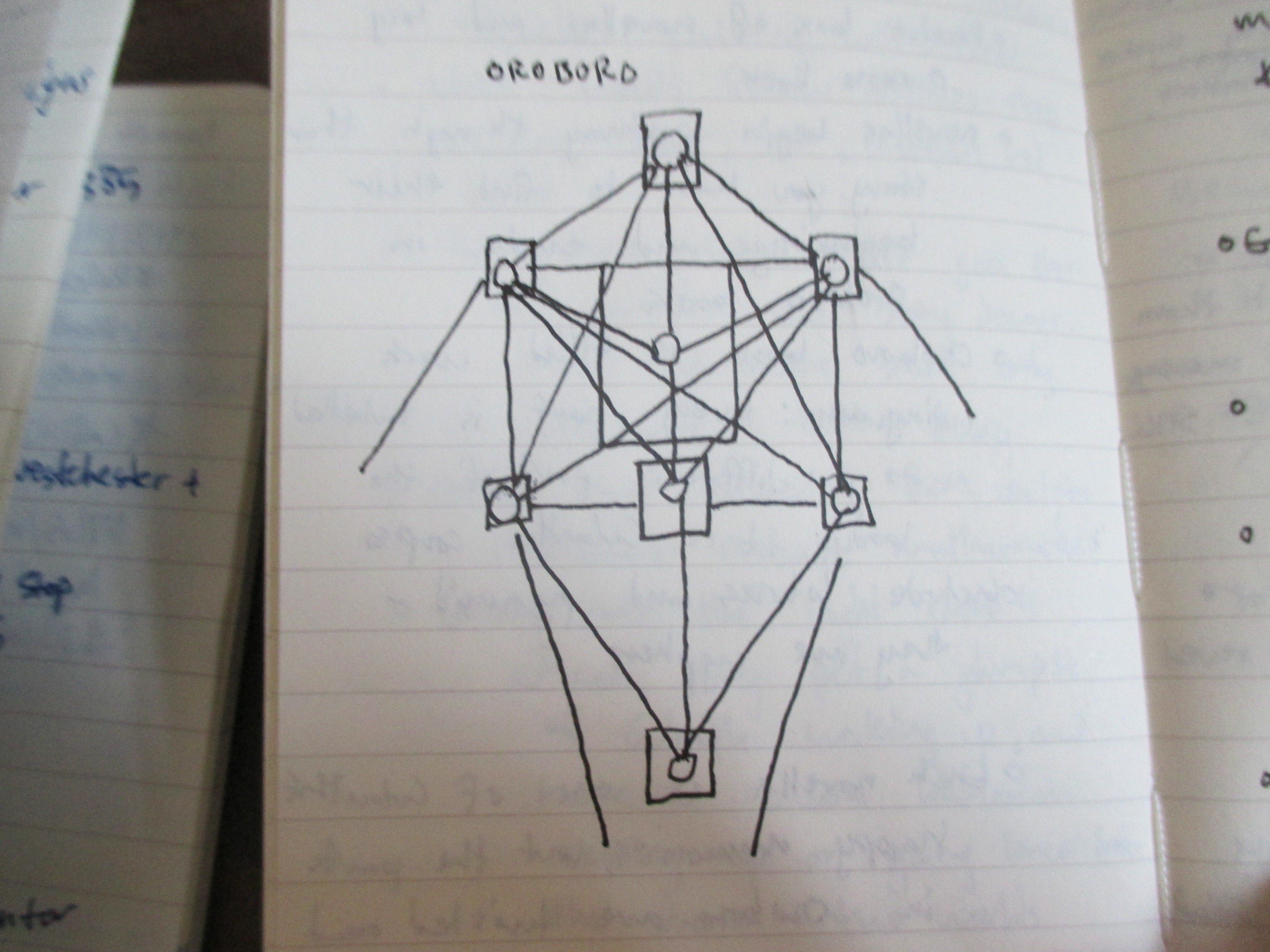Be sure to read Part 1 of ERGODICA here.
Last post, I brought up the idea of a “corpse book,” a piece of ergodic literature that uses the human body as the blueprint for its narrative structure. Before I start unpacking the insanity behind this idea and the ensuing project (which will involve philosophy, mathematics, occultism, and the nature of reality) it’s helpful to know what the hell “ergodic” means. According to the internet, “ergodic” means:
“relating to or denoting systems or processes with the property that, given sufficient time, they include or impinge on all points in a given space and can be represented statistically by a reasonably large selection of points”
Ergodic literature, however, is defined as the following:
“In ergodic literature, nontrivial effort is required to allow the reader to traverse the text. If ergodic literature is to make sense as a concept, there must also be nonergodic literature, where the effort to traverse the text is trivial, with no extranoematic responsibilities placed on the reader except (for example) eye movement and the periodic or arbitrary turning of pages.”
The corpse book, as I imagine it, makes sense in both of these definitons–mathematical and literary. So sit back and open your mind here–we’re going to take a journey into the wondrous world of imagination, starting with the oh-so-fun topic of death and Kierkegaard.
There is a famous work written by Soren Kierkegaard, under the name Anti-Climacus, titled “The Sickness Unto Death.” The title comes from the Bible, in the Gospel of John–in that Gospel, Jesus comes across a dying man named Lazarus, and utters the words “This sickness is not unto death, but for the glory of God.” ‘This sickness’ refers to his dying condition, and the meaning of Jesus’ statement can be read as “This man’s death isn’t for nothing–it is part of God’s plan.”
Death is the focus of a lot of different philosophies, but especially existentialism and Zen Buddhism: death represents the annihilation of the self, including our memories, our personalities, and everything that forms our identity. Death, in a lot of ways, is the crux of all philosophy, which led Albert Camus (who I hate) to say that the only true philosophical question worth pondering is suicide.
For Kierkegaard, the truly frightening thing is the sickness unto death, the death that is for nothing and no one, the death that means nothing. Kierkegaard imagines the human soul as trapped between the infinite and finite, always being pulled in both directions at once: on the one hand, we are divine creatures with immortal souls, but on the other we are bound to our bodies, senses, and everything that entails. The pursuit to reconcile these two is the heart of Kierkegaard’s existentialism, and offers a meaning to life. But to reject that quest, to say  “fuck the infinite and the finite!”, is to choose despair. To choose despair, and to keep living, is to choose the sickness unto death.
“fuck the infinite and the finite!”, is to choose despair. To choose despair, and to keep living, is to choose the sickness unto death.
In my stories and my world, the question of the sickness unto death is the chief philosophical concern. Death comes about from one thing: decay. So necromancy has risen up to deal with the practical concerns: how to keep the body intact and repaired ad infinitum, how to move a soul out of a decaying flesh body into a vessel like a phylactery or an artificial body, etc. Some kinds of necromancy, even more complicated and rare, aim to alter the body’s place in time, allowing people to slice minutes or seconds as thin as hairs, stretching out the moments. In all of these cases, the body is the central concern. Without a body, you have no tie to earthly existence, to the finite. So the body is the chief concern of necromancers.
This is the central feature of the “corpse book” I’m imagining: to tell a story about a necromancer, the story itself would have to take on the form of a body…or a corpse.
Part 2: Kabbalah, Evangelion, and the Oneness of Things
In Kabbalah, the Sephiroth is a map of all god’s creation, laid out symbolically. It’s made of twelve different parts, called sephira, each one representing a different aspect of the universe, God, and a step on the path to ultimate enlightenment. As you climb up the Tree, from the lower to the higher  sephira, more is revealed by the different interconnections between them: the relationships between the sephira mean as much as the sephira themselves, creating layers and nets of meaning.
sephira, more is revealed by the different interconnections between them: the relationships between the sephira mean as much as the sephira themselves, creating layers and nets of meaning.
One of the many ways to understand the relation of the different sephira is to see them as parts of a giant body, with the feet (malkuth, the lowest sephira, representing the material world) touching earthly existence and the head (Kether, the highest sephira, representing God’s consciousness) touching the heavens. With this symbolism, the human body itself becomes a map of the universe and the path to enlightenment.
Incidentally, this is one of the reasons Evangelion pisses me off so much, making me say “God DAMN it, that’s clever.”
The Tree of Sephiroth shows up as a consistent motif across the Evangelion series, all the way to End of Evangelion, where the Mass Production EVAs enact a ritual that lifts the crucified EVA-01 into the sky, rising in a formation with an overlaid Sephiroth pattern, each EVA representing a different sephira. Below, from the clouds, rises a giant white body, which is the unity of Lilith (the female aspect of creation) and Adam (the male aspect of creation). The giant Lilith-Adam becomes the catalyst for Instrumentality,  subsuming Shinji and all human souls into itself in order to either destroy humanity or cause its rebirth. So what we’re given here is a literal reenactment of the Sephiroth, the map to the totality of God’s creation, as a giant human body initiating the destruction and creation of the world. The giant has its feet on the surface of the Earth, and it’s head is in fucking space, staring at Shinji so he can have a liaison with Kether by being literally sucked into Rei’s forehead.
subsuming Shinji and all human souls into itself in order to either destroy humanity or cause its rebirth. So what we’re given here is a literal reenactment of the Sephiroth, the map to the totality of God’s creation, as a giant human body initiating the destruction and creation of the world. The giant has its feet on the surface of the Earth, and it’s head is in fucking space, staring at Shinji so he can have a liaison with Kether by being literally sucked into Rei’s forehead.
So there you have it: a narrative, visual synthesis of Kabbalah, a protagonist’s literal apotheosis, and the culmination of a story about understanding the human condition through one person’s journey into themselves. It’s perfect. Damn it.
The relationship of the Sephiroth to the human body speaks to an interesting phenomenon in mysticism and philosophy: the multiple meanings of things, and the conflation of different meanings. The Tree of Sephiroth can represent the human body just as it represents the map of creation, just as it represents a map of the path to enlightenment, just as it represents God. Thus, the body is the universe is God is enlightenment. This is why mystics keep talking about the “oneness” of things, that we are all “one.” To their eyes, the eyes of the enlightened, everything is everything else. The smallest insect is an expression of the ultimate truth of being, just as the rhizomantic nature of a flock of birds points to the order within the seeming chaos of being. The world is filled with hidden symmetries and patterns that all form the tip of a single iceberg.
It all sounds like some real mystical bullshit until you become aware of the existence of fractals.
Part 3: Fractals, Infinity, and Triangular Gaskets
So the human body, the vessel of the soul and the central feature of necromancy in my world, has a lot of meaning attached to it. Most of these meanings transcend the flesh and blood of human anatomy, but some are very literally embedded in it. Fractals are “a natural phenomenon or a mathematical set that exhibits a repeating pattern that displays at every scale.” Fractals have a metapattern that nests within itself, with the smallest complete part of the pattern being a miniature reflection of the whole pattern.
Fractals show up in snowflakes, wave patterns in the ocean, cryst als, and plants, among other places. When electricity is injected into certain mediums, the resulting branching pattern has fractal qualities. But the most immediate example is human veins, which resemble patterns called L-Systems. L-systems are also found in tree limbs and wheat stalks, and appears in mathematical models of population growth for simple kinds of life, like algae. In pure mathematics they show up in Pascal’s Triangle and infinite recursion, among dozens of other places. In each of these cases, the fractals form patterns that nest inside themselves and expand outside of themselves forever–in their purest forms, fractal patterns are infinite.
als, and plants, among other places. When electricity is injected into certain mediums, the resulting branching pattern has fractal qualities. But the most immediate example is human veins, which resemble patterns called L-Systems. L-systems are also found in tree limbs and wheat stalks, and appears in mathematical models of population growth for simple kinds of life, like algae. In pure mathematics they show up in Pascal’s Triangle and infinite recursion, among dozens of other places. In each of these cases, the fractals form patterns that nest inside themselves and expand outside of themselves forever–in their purest forms, fractal patterns are infinite.

So let’s break this down. There is a type of pattern that is found in both nature and in pure mathematics that affirms the idea that no matter how large or complicated the pattern, the smallest piece of something can reflect its whole. This pattern has within its very nature the potential to be infinite, but is also found in finite forms: veins within human bodies, branches on trees, etc. Fractals seem to be, in a lot of really fascinating ways, a bridge to understanding the way to reconcile the impossible poles of the finite and infinite, the micro-scale and the macro-scale. Contained within fractal patterns, then, is potentially an expression of the path to enlightenment.
But then there’s the Hausdorff dimension.
I am not a mathematician. I’ve said this before, I’ll say it again. But the relationship between fractals and their Hausdorff dimension, to me, is one that seems to evoke sheer madness.
When you measure the sides of a square, you get a solid number. 10 centimeters. 18.465 centimeters. But when you try to measure a fractal shapes’ dimensions, the answer depends on how big your magnifying glass is. Since true fractals repeat in smaller and smaller iterations forever, measuring a true fractal would be impossible, since every time you tried to measure a part of it, you would discover an even smaller part contained within it which needed measuring, and an even smaller part within that one. Think of cutting the corners off of a table, turning a square into an octagon. Then cut the corners off the octagon. So on. This is something akin to the famous Zeno’s Paradox, mentioned in my previous post about Mr. Powell.
The Hausdorff dimension tries to measure the dimension of objects, whether one dimensional or three dimensional. Usually the Hausdorff dimension can be expressed as a whole integer, like 2 or 3. But fractals, which tinker with infinity, have bizarre Hausdorff dimensions, ones that defy logic or reality. They’re anomalous, impossible, but like the arrow in Zeno’s Paradox, it’s hard to draw the line between being mathematically impossible and physically impossible–especially when fractals seem to form some of the underlying patterns across nature and math.
My favorite is still the previously mentioned Pascal’s Triangle, which was part of the inspiration for “Chris Mahon’s Occult Triangle Lab.” The patterns within the triangle, when drawn out, create a well-known fractal pattern, the Sierpinski Gasket.


Part 4: Fractal Immortality, Interdimensional Necromancy, and You
I mentioned a couple ways that necromancy deals with staving off death from the physical body. I mentioned the alteration of the body through repair or the use of a vessel, like a phylactery. I also mentioned the manipulation of time.
Imagine you’re a particularly clever necromancer, one who explores the soul’s connection between the infinite and the finite, those two binary positions. If the finite is expressed as 1, then the infinite could be expressed as 0. These are mathematical limits, and the human soul exists between them somewhere. But what if you explored mathematics in addition to necromancy? Things like Zeno’s Paradox and the nature of fractals. You would find that between two limits, even 0 and 1, there is an infinity of points curling in on themselves, nested upon one another to eternity. If the human Hausdorff dimension exists somewhere between 0 and 1, is there a bizarre decimal value, a little valley where you could live inside the limits but outside of existence? Is it possible for mathematics to come across a piece of math that takes it outside of anything math can explain?
It’s absolutely possible. In fact, it’s impossible to prove it’s not.
There’s a theory called Godel’s Incompleteness Theorem. From Wikipedia:
“The first incompleteness theorem states that no consistent system of axioms whose theorems can be listed by an “effective procedure” (i.e., any sort of algorithm) is capable of proving all truths about the relations of the natural numbers (arithmetic). For any such system, there will always be statements about the natural numbers that are true, but that are unprovable within the system. The second incompleteness theorem, an extension of the first, shows that such a system cannot demonstrate its own consistency.”
What this boils down to is that there is no way to definitively prove that any given system, like mathematics, is consistent when you use that system to test itself. So imagine you want to escape the finite and the infinite from within that system of 0 and 1. It’s not impossible. In fact, there are already things within that boundary that show that there’s whole worlds within the bounds of 0 and 1, where everything breaks down and the rules become meaningless: fractals.
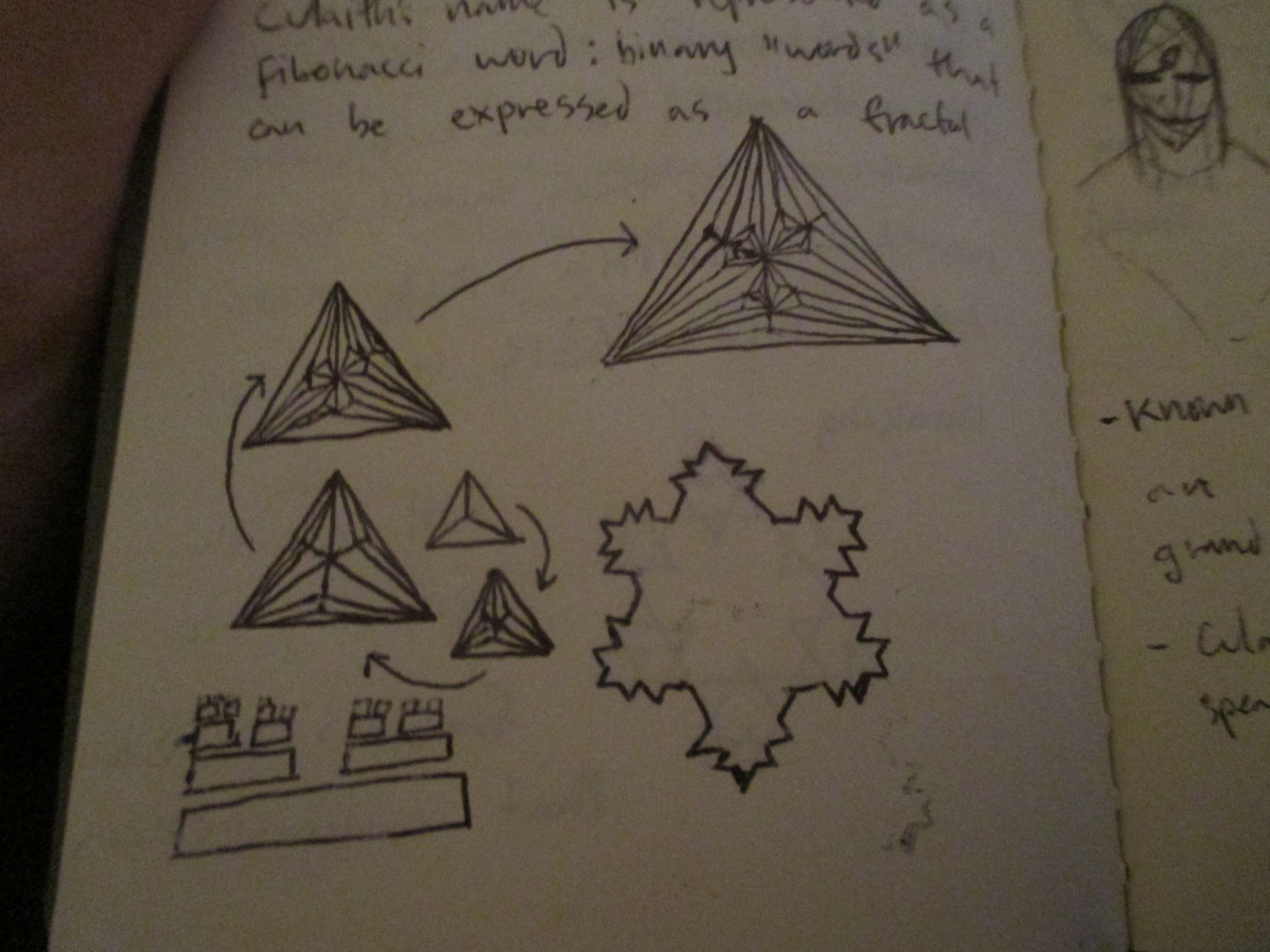 Imagine escaping three dimensions for 1.38 dimensions. Death has no meaning there. Your body has no meaning there. It’s a kind of infinity, just a smaller type, a stranger type within a bigger infinity. Your soul, your self, that’s infinite, too. You could live forever. But it’s the crossing over that would be difficult–transcending or descending from this dimension.
Imagine escaping three dimensions for 1.38 dimensions. Death has no meaning there. Your body has no meaning there. It’s a kind of infinity, just a smaller type, a stranger type within a bigger infinity. Your soul, your self, that’s infinite, too. You could live forever. But it’s the crossing over that would be difficult–transcending or descending from this dimension.
And this is where everything goes wrong for our necromantic protagonist.
He doesn’t make it from this dimension into the fractal dimension. He makes a mistake, somewhere deep in his arcane mathematics. And now his soul, his self, is trapped between the finite, the infinite, and another, fractal infinity. As you can probably imagine, this non-Euclidean, neo-Lovecraftian experience can drive a person insane.
The effect of this cross-dimensional interpollation, in my conception, would be the decay of the soul instead of the body: instead of hanging in stasis between finite and infinite, the closed system would become unstable, with the soul getting ripped apart and slowly sucked into the fractal dimension like water going down a drain. This would be a gradual annihilation of the soul over a period of time that couldn’t be measured in reality, but rather by its own, internal clock.
This would be the plot of the corpse book.
Part 5: Ergodic Literature, Ciphers, and Counting Down to Annihilation
Fractals form the heart of the structure and narrative of this book, linking together time, death, immortality, the decay of the body, the infinite, finite, and wide-eyed madness, and the way to read about it all necessitates a special way to navigate the story.
The story told in this corpse book is one told across several limbs, or tertiary books, all of which are interconnected in the same manner of the Tree of Sephiroth. All of the books combined represent the symbolic body of the protagonist, divided into respective facets of his self.
In my current plan, each of these limb books are to contain approximately 10,500 words. This is because the average person reads at roughly 175 words per minute. With five limb books (head, feet, arms) and a central “torso” book of 63,00 words, that adds up to roughly 12 hours of reading time. This is the “internal clock” I was talking about: as you’re reading each word, minutes pass in both your world and the world of the narrative, meaning that the protagonist’s soul is gradually dissolving in real time.
These are the last 12 hours of his life, and the individual pieces of his self are disappearing one by one, infinity eating him alive. The name of the book would be OROBORO.
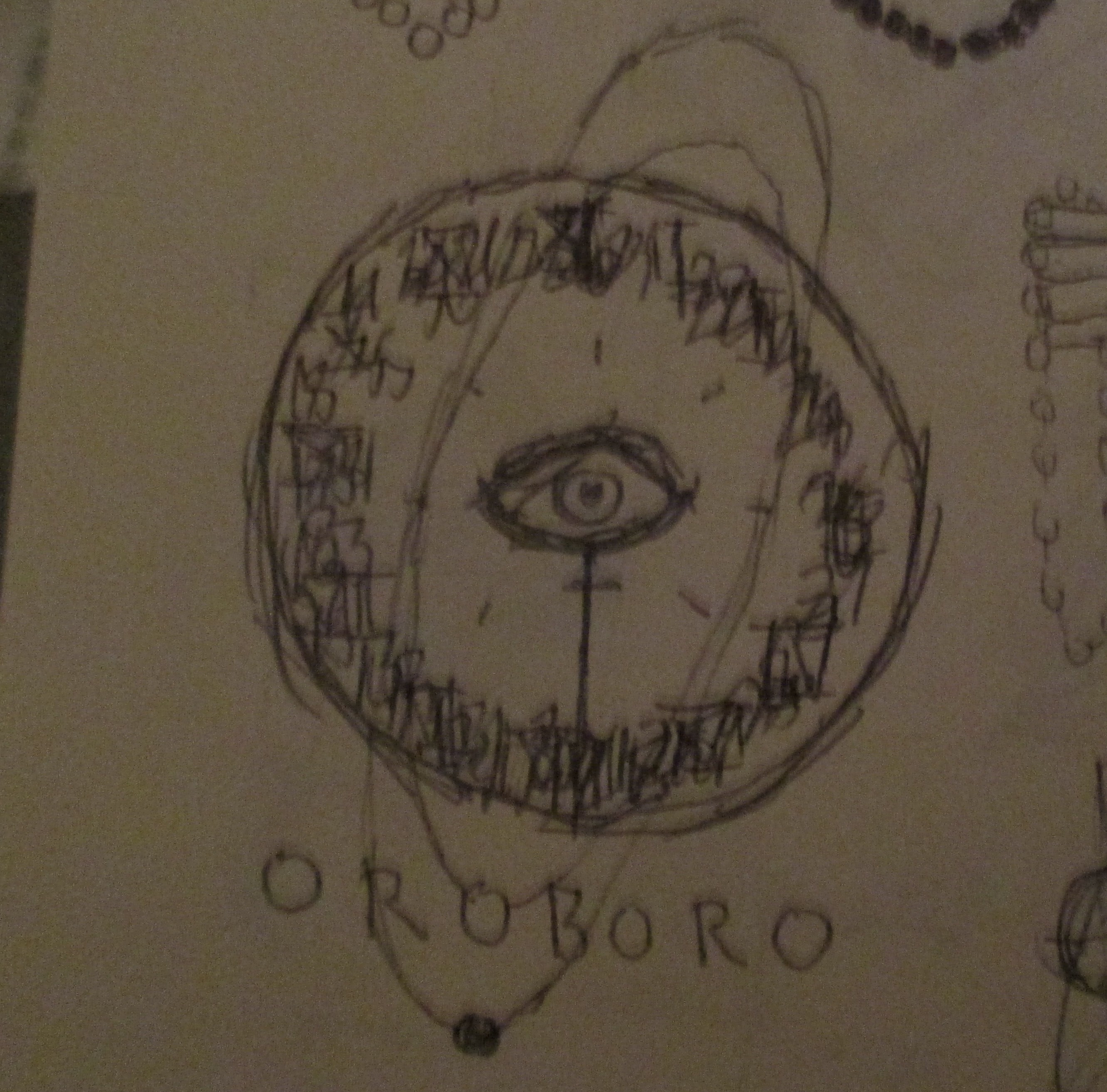
Imagine trying to navigate a mind like that. Instead of a clean, perfectly symmetrical path across his Sephiroth, the path would be jumbled, fragmented, insane. This would be more like piecing together a falling building than reading the linear chronology of an adventure. So I imagine that each limb book would be fragmented, asking you to return to the central torso book a couple times to help unravel its individual story, with the narrative crossing the boundaries between the books and the reader decoding the path forward as they go along.
My initial idea is to have a word or a name become a cipher, something with significance. Using a process similar to my last post about encoding true names into hexadecimal or binary, certain phrases would be ciphers to figure out the path of the narrative, whether that was a page number, a certain passage, or one of the other limb books though I’d probably keep the torso book as the main “reference” book for each limb book to keep things simpler. The torso book would be like a dictionary or an astrology chart peppered with hidden pieces of the story, unintelligible until you saw the rest of the puzzle.
Tied into this idea of moving between a cipher guiding a reader’s path through the torso book and the constant decay of the protagonist’s soul in real time, I thought it would be appropriate to use a system that involved modular arithmetic, the same system that clocks use.
 The modulo would begin at twelve, the number of hours until the final dissolution of the protagonist’s soul, and with each passing limb book (which take 2 hours to read), the modulo would decrease by 2. The advantage is that the modulo system is a relatively easy kind of mental arithmetic, something readers could do in their heads or on the back of a Post-It. Another possibility would be to use a Sierpinski gasket as the main mechanic, using the numbers and patterns contained in it as an easy cipher.
The modulo would begin at twelve, the number of hours until the final dissolution of the protagonist’s soul, and with each passing limb book (which take 2 hours to read), the modulo would decrease by 2. The advantage is that the modulo system is a relatively easy kind of mental arithmetic, something readers could do in their heads or on the back of a Post-It. Another possibility would be to use a Sierpinski gasket as the main mechanic, using the numbers and patterns contained in it as an easy cipher.
If everything is done right, the process of figuring out the cipher will force the reader to inhabit the same mindset as the protagonist himself, immersing them in the same world of arcane mathematics and hidden patterns that brought him to where he is now. This is a world of fantasy, after all: a world of wizards and necromancers who bury themselves in old, dusty, esoteric tomes to find forbidden knowledge that takes them deep into an unseen world.
It reminds me of H.P. Lovecraft’s Mountains of Madness, in some ways. Once the heroes penetrate the city of the Old Ones and begin exploring its depths, they begin to find walls of pictograms that show their history, from their arrival on earth to the rebellion of the Shoggoths. There’s dozens of pages recounting this history as the protagonist unravels it, and instead of feeling like it’s an information dump, it begins to illuminate everything else about the city.

The way I see it, the whole cipher-puzzle system asks readers to learn something new as they read, picking up the skills and mindset naturally as they follow the narrative, until they find themselves applying it to advance the story. The story would ask you not just to absorb it, but navigate it, and that navigation would bring you closer to understanding the central character and the esoteric, frightening, and entrancing arts of interdimensional immortality, and what drove him to seek it out.
Part 6: V FOR VENDETTA, Ideas, and the Outro
So what we have is Kierkegaard’s existentialism, Buddhism, immortality, Kabbalah, fractals, and Godel’s Incompleteness theorem woven into a piece of experimental literature about an interdimensional necromancer trapped between two infinities. That’s the basic layout of this project I’m working on, the elevator pitch. It’s fun to weave all these ideas together, to play around with them and find weird, interesting parallels and symmetries. When I read V FOR VENDETTA, one of the things I wondered was if Alan Moore and his co-writer started getting freaked out when they put together all of the striking connections between Guy Fawkes, the letter V, and the number 5, the symbol for anarchy, quotes from Faust, and the story they were weaving. It seemed like it all fit together too well, as if these patterns were all there from the beginning, waiting to be discovered. Of course, when you’re a writer you try to force everything to fit together into a perfect thematic pattern, but maybe there comes a point, like in Foucault’s Pendulum, when yo u begin to feel like you are part of the pattern, not the one creating it. Terrifyingly enough, that sentiment, too, is part of V FOR VENDETTA:
u begin to feel like you are part of the pattern, not the one creating it. Terrifyingly enough, that sentiment, too, is part of V FOR VENDETTA:
“I had to see it. There wasn’t much left. But when I was there it was strange. I suddenly had this feeling that everything was connected. It’s like I could see the whole thing, one long chain of events that stretched all the way back before Larkhill. I felt like I could see everything that happened, and everything that is going to happen. It was like a perfect pattern, laid out in front of me. And I realised we’re all part of it, and all trapped by it.”
There’s a lot more to writing a story that piecing together a lot of really cool ideas. I said that before about Neal Stephenson. But a famous writer once said that writers end up writing the kind of thing that they want to read. This is the kind of thing I want to read, because it’s exciting, bizarre, and fascinating. I bet if I looked, I could find other people who think the same thing. It’s inspiring to test the bounds of imagination and creativity and storytelling. I think that’s one of the things that makes writing fiction so unique.
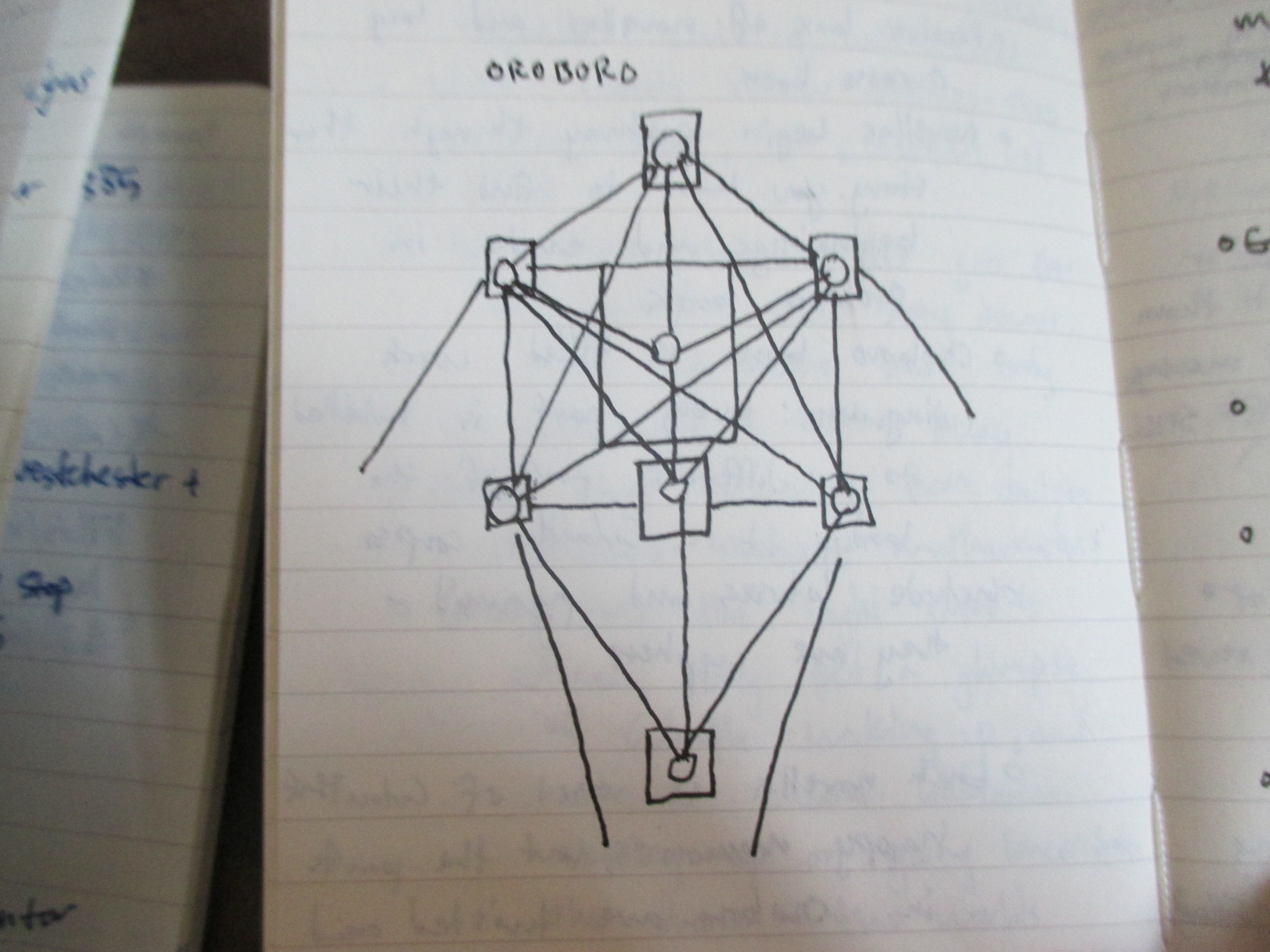

























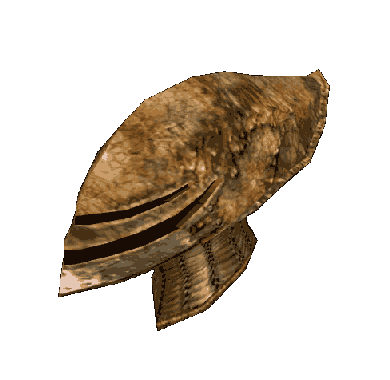








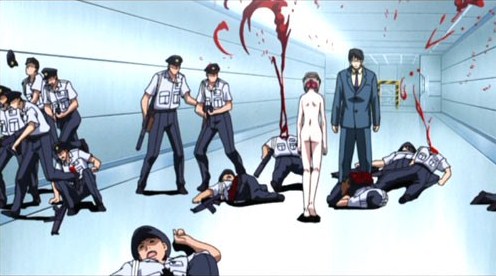 And
And 






 “fuck the infinite and the finite!”, is to choose despair. To choose despair, and to keep living, is to choose the sickness unto death.
“fuck the infinite and the finite!”, is to choose despair. To choose despair, and to keep living, is to choose the sickness unto death. sephira, more is revealed by the different interconnections between them: the relationships between the sephira mean as much as the sephira themselves, creating layers and nets of meaning.
sephira, more is revealed by the different interconnections between them: the relationships between the sephira mean as much as the sephira themselves, creating layers and nets of meaning. subsuming Shinji and all human souls into itself in order to either destroy humanity or cause its rebirth. So what we’re given here is a literal reenactment of the Sephiroth, the map to the totality of God’s creation, as a giant human body initiating the destruction and creation of the world. The giant has its feet on the surface of the Earth, and it’s head is in fucking space, staring at Shinji so he can have a liaison with Kether by being literally sucked into Rei’s forehead.
subsuming Shinji and all human souls into itself in order to either destroy humanity or cause its rebirth. So what we’re given here is a literal reenactment of the Sephiroth, the map to the totality of God’s creation, as a giant human body initiating the destruction and creation of the world. The giant has its feet on the surface of the Earth, and it’s head is in fucking space, staring at Shinji so he can have a liaison with Kether by being literally sucked into Rei’s forehead. als, and plants, among other places. When electricity is injected into certain mediums, the resulting branching pattern has fractal qualities. But the most immediate example is human veins, which resemble patterns called L-Systems. L-systems are also found in tree limbs and wheat stalks, and appears in mathematical models of population growth for simple kinds of life, like algae. In pure mathematics they show up in Pascal’s Triangle and infinite recursion, among dozens of other places. In each of these cases, the fractals form patterns that nest inside themselves and expand outside of themselves forever–in their purest forms, fractal patterns are infinite.
als, and plants, among other places. When electricity is injected into certain mediums, the resulting branching pattern has fractal qualities. But the most immediate example is human veins, which resemble patterns called L-Systems. L-systems are also found in tree limbs and wheat stalks, and appears in mathematical models of population growth for simple kinds of life, like algae. In pure mathematics they show up in Pascal’s Triangle and infinite recursion, among dozens of other places. In each of these cases, the fractals form patterns that nest inside themselves and expand outside of themselves forever–in their purest forms, fractal patterns are infinite.


 Imagine escaping three dimensions for 1.38 dimensions. Death has no meaning there. Your body has no meaning there. It’s a kind of infinity, just a smaller type, a stranger type within a bigger infinity. Your soul, your self, that’s infinite, too. You could live forever. But it’s the crossing over that would be difficult–transcending or descending from this dimension.
Imagine escaping three dimensions for 1.38 dimensions. Death has no meaning there. Your body has no meaning there. It’s a kind of infinity, just a smaller type, a stranger type within a bigger infinity. Your soul, your self, that’s infinite, too. You could live forever. But it’s the crossing over that would be difficult–transcending or descending from this dimension.
 The modulo would begin at twelve, the number of hours until the final dissolution of the protagonist’s soul, and with each passing limb book (which take 2 hours to read), the modulo would decrease by 2. The advantage is that the modulo system is a relatively easy kind of mental arithmetic, something readers could do in their heads or on the back of a Post-It. Another possibility would be to use a Sierpinski gasket as the main mechanic, using the numbers and patterns contained in it as an easy cipher.
The modulo would begin at twelve, the number of hours until the final dissolution of the protagonist’s soul, and with each passing limb book (which take 2 hours to read), the modulo would decrease by 2. The advantage is that the modulo system is a relatively easy kind of mental arithmetic, something readers could do in their heads or on the back of a Post-It. Another possibility would be to use a Sierpinski gasket as the main mechanic, using the numbers and patterns contained in it as an easy cipher.
 u begin to feel like you are part of the pattern, not the one creating it. Terrifyingly enough, that sentiment, too, is part of V FOR VENDETTA:
u begin to feel like you are part of the pattern, not the one creating it. Terrifyingly enough, that sentiment, too, is part of V FOR VENDETTA:








 pieces of metanarrative, but Johnny Truant’s invasive footnotes, evocative of someone else’s mind invading the story, had no substance to them, nothing that fit together with the dry scholarly passages about the Navidson Record and the drama of the expeditions into the heart of the house. And that’s my main critique of most of the book: these fantastic, inventive typographical tricks didn’t come together as a cohesive whole to evoke the story it was telling. Instead, it ended up as mostly white noise, a bunch of jigsaw pieces glued onto a very compelling nucleus, the house, whose borders and boundaries can’t be contained in space, time, or (potentially) the book itself.
pieces of metanarrative, but Johnny Truant’s invasive footnotes, evocative of someone else’s mind invading the story, had no substance to them, nothing that fit together with the dry scholarly passages about the Navidson Record and the drama of the expeditions into the heart of the house. And that’s my main critique of most of the book: these fantastic, inventive typographical tricks didn’t come together as a cohesive whole to evoke the story it was telling. Instead, it ended up as mostly white noise, a bunch of jigsaw pieces glued onto a very compelling nucleus, the house, whose borders and boundaries can’t be contained in space, time, or (potentially) the book itself. A good counterexample of a piece of experimental literature that did its job well is Trillium, the graphic novel with Jeff Lemire. It takes a lot of skill to make a reader just flip a book upside down, but Trillium gave an amazing narrative reason to do just that: at one point in the book, the narrative splits into two parallel universes, and so the panels are actually running parallel to one another, but flipped so you don’t read both timelines at once. This makes you focus on one at a time while also getting little peripheral glimpses of what’s to come. It’s genius, and it works because it’s coherent, intuitive to navigate, and grounded in the narrative. You know why it’s happening, how to read it, and what it means for the story.
A good counterexample of a piece of experimental literature that did its job well is Trillium, the graphic novel with Jeff Lemire. It takes a lot of skill to make a reader just flip a book upside down, but Trillium gave an amazing narrative reason to do just that: at one point in the book, the narrative splits into two parallel universes, and so the panels are actually running parallel to one another, but flipped so you don’t read both timelines at once. This makes you focus on one at a time while also getting little peripheral glimpses of what’s to come. It’s genius, and it works because it’s coherent, intuitive to navigate, and grounded in the narrative. You know why it’s happening, how to read it, and what it means for the story.